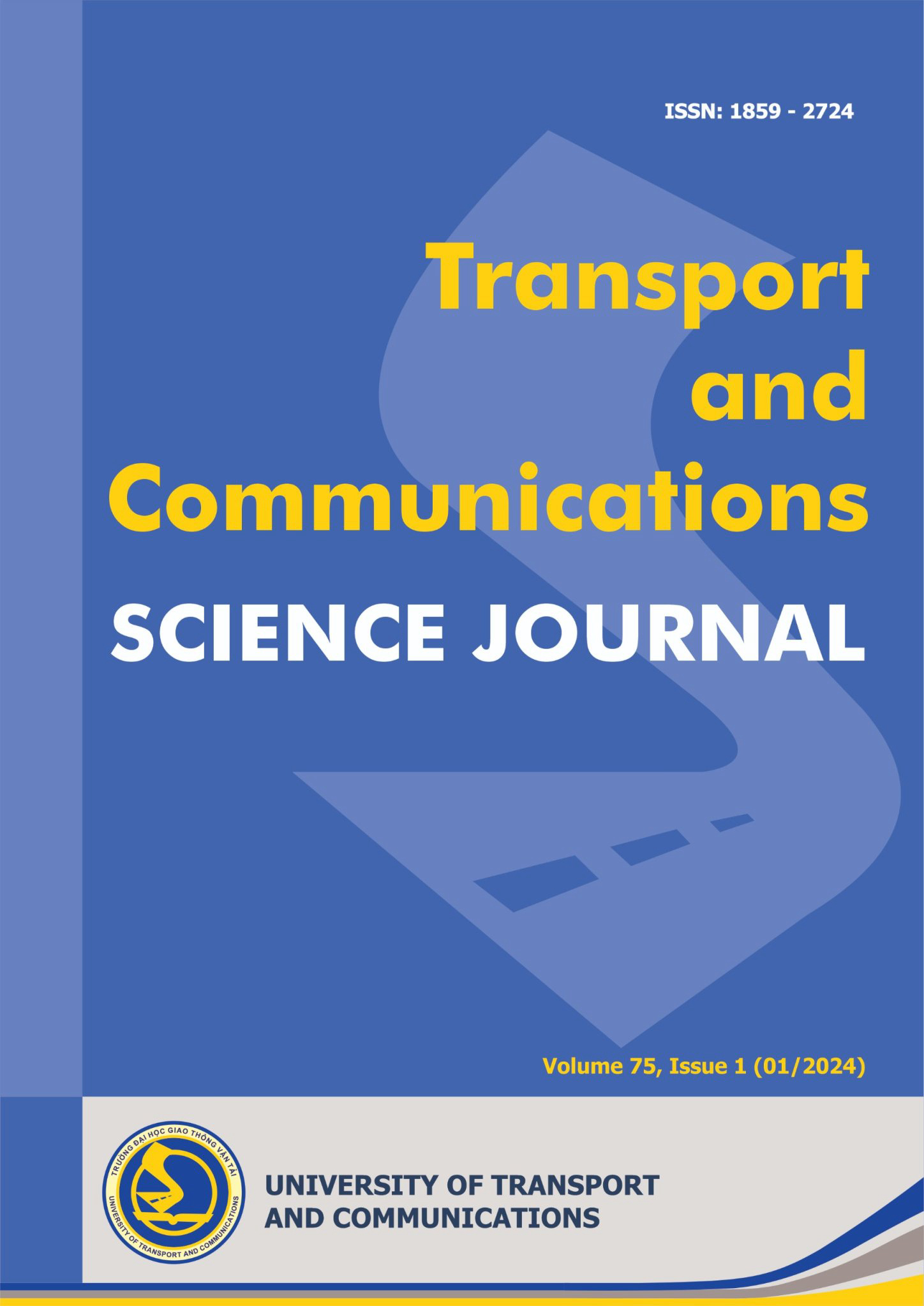Simulation of four-point bending tests for the viscoelastic fracture properties of concrete
Email:
tranhung@lqdtu.edu.vn
Từ khóa:
Numerical concrete simulation, viscoelastic fracture properties, four-point bending test, initial crack-depth ratio.
Tóm tắt
Understanding the fracture properties of concrete, such as crack propagation behavior and fracture energy, is crucial for designing and evaluating concrete structures. Experimental results are insufficient and cannot be directly employed for a comprehensive analysis of the fracture behavior of concrete structures under load, particularly when considering concrete as viscoelastic with the presence of cracks. Recognizing the time and cost constraints of traditional experimental testing, this research leverages numerical simulations as a cost-effective alternative to determine viscoelastic material parameters. Thus, the critical evaluation of concrete fracture properties, fundamental for the design and assessment of concrete structures, is addressed. Employing a finite element method for four-point bending tests, the study systematically investigates parameters such as initial crack depth, displacement acceleration, and time step. The material properties of concrete are described using viscoelastic models. The findings provide valuable insights into crack propagation behavior and deformation characteristics, emphasizing the significant influence of the modulus of elasticity on both maximum load values and displacement. These findings contribute to a deeper understanding of the structure's response and underscore the importance of considering these parameters in similar simulations. The study highlights the importance of considering these parameters in simulations to enhance the understanding of concrete fracture behavior. The paper's contributions can extend to optimizing concrete mixtures, formulating repair strategies, and improving structural assessments. Further research is suggested to improve the accuracy of simulations and investigate material properties under various conditions.Tài liệu tham khảo
[1]. Y. Yin, Y. Qiao, S. Hu, Four-point bending tests for the fracture properties of concrete, Engineering Fracture Mechanics, 211 (2019) 371-381. https://doi.org/10.1016/j.engfracmech.2019.03.004
[2]. W. Kan, Z. Yang, W. Yin, Simulation of Four-Point Bending Fracture Test of Steel-Fiber-Reinforced Concrete, Materials, 15 (2022) 7146. https://doi.org/10.3390/ma15207146
[3]. C. Barris, P. Zubillaga, L. Torres, A review on experimental flexural cracking in FRP reinforced concrete members, In: Proceedings of the IABSE Symposium, Guimaraes (2019). https://doi.org/10.2749/guimaraes.2019.0088
[4]. Y. X. Zhao, H. Xu, W. L. Jin, Concrete cracking process induced by steel corrosion-A review, In: Proceedings of the Thirteenth East Asia-Pacific Conference on Structural Engineering and Construction (EASEC-13) (2013, September), pp. Keynote-Lecture 5.
[5] D. Lau, O. Büyüköztürk, Fracture characterization of concrete/epoxy interface affected by moisture, Mechanics of Materials, 42 (2010) 1031-1042. https://doi.org/10.1016/j.mechmat.2010.09.001
[6]. W. Dong, X. Zhang, B. Zhang, Q. Wu, Influence of sustained loading on fracture properties of concrete, Engineering fracture mechanics, 200 (2018) 134-145. https://doi.org/10.1016/j.engfracmech.2018.07.034
[7]. J. P. Ulfkjaer, Fracture Energy of Normal Strength Concrete, High Strength Concrete and Ultra High Strength Ultra Ductile Fibre Reinforced Concrete, Proceedings FRAMCOS-2 (1995) 31-44.
[8]. M. Leone, G. Centonze, D. Colonna, F. Micelli, M. A. Aiello, Fiber-reinforced concrete with low content of recycled steel fiber: Shear behaviour, Construction and Building Materials, 161 (2018) 141-155. https://doi.org/10.1016/j.conbuildmat.2017.11.101
[9]. N. H. Tran, T. T. N. Nguyen, T. H. Vo, Enhancing the efficiency of textile reinforced concrete (TRC) for strengthened reinforced concrete beams, International conference-Construction science and Technology toward sustainable development, IBST-Hanoi, (2023, November 10th), pp. 135-142 (in Vietnamese).
[10]. S. T. Nguyen, Propagation de fissures et endommagement par microfissures des matériaux viscoélastiques linéaires non vieillissants (in French), Doctoral thesis, Université Paris Est, 2010.
[2]. W. Kan, Z. Yang, W. Yin, Simulation of Four-Point Bending Fracture Test of Steel-Fiber-Reinforced Concrete, Materials, 15 (2022) 7146. https://doi.org/10.3390/ma15207146
[3]. C. Barris, P. Zubillaga, L. Torres, A review on experimental flexural cracking in FRP reinforced concrete members, In: Proceedings of the IABSE Symposium, Guimaraes (2019). https://doi.org/10.2749/guimaraes.2019.0088
[4]. Y. X. Zhao, H. Xu, W. L. Jin, Concrete cracking process induced by steel corrosion-A review, In: Proceedings of the Thirteenth East Asia-Pacific Conference on Structural Engineering and Construction (EASEC-13) (2013, September), pp. Keynote-Lecture 5.
[5] D. Lau, O. Büyüköztürk, Fracture characterization of concrete/epoxy interface affected by moisture, Mechanics of Materials, 42 (2010) 1031-1042. https://doi.org/10.1016/j.mechmat.2010.09.001
[6]. W. Dong, X. Zhang, B. Zhang, Q. Wu, Influence of sustained loading on fracture properties of concrete, Engineering fracture mechanics, 200 (2018) 134-145. https://doi.org/10.1016/j.engfracmech.2018.07.034
[7]. J. P. Ulfkjaer, Fracture Energy of Normal Strength Concrete, High Strength Concrete and Ultra High Strength Ultra Ductile Fibre Reinforced Concrete, Proceedings FRAMCOS-2 (1995) 31-44.
[8]. M. Leone, G. Centonze, D. Colonna, F. Micelli, M. A. Aiello, Fiber-reinforced concrete with low content of recycled steel fiber: Shear behaviour, Construction and Building Materials, 161 (2018) 141-155. https://doi.org/10.1016/j.conbuildmat.2017.11.101
[9]. N. H. Tran, T. T. N. Nguyen, T. H. Vo, Enhancing the efficiency of textile reinforced concrete (TRC) for strengthened reinforced concrete beams, International conference-Construction science and Technology toward sustainable development, IBST-Hanoi, (2023, November 10th), pp. 135-142 (in Vietnamese).
[10]. S. T. Nguyen, Propagation de fissures et endommagement par microfissures des matériaux viscoélastiques linéaires non vieillissants (in French), Doctoral thesis, Université Paris Est, 2010.
Tải xuống
Chưa có dữ liệu thống kê

Nhận bài
03/07/2023
Nhận bài sửa
31/08/2023
Chấp nhận đăng
10/01/2024
Xuất bản
15/01/2024
Chuyên mục
Công trình khoa học
Kiểu trích dẫn
Tran Nam, H., & Nguyen Thi Thu, N. (1705251600). Simulation of four-point bending tests for the viscoelastic fracture properties of concrete. Tạp Chí Khoa Học Giao Thông Vận Tải, 75(1), 1169-1182. https://doi.org/10.47869/tcsj.75.1.6
Số lần xem tóm tắt
209
Số lần xem bài báo
111









